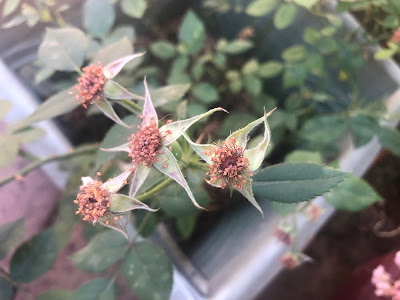
A morning inspection can catch growing problems

Early morning in May, time for Garden Patrol. Accompanied by four-legged Garden Supervisor Elsie T. Katt, I do a quick walk through my front and back gardens, making mental notes on what's happened to plants overnight. Already checked the weather report — it's going to be 91 today, down a bit from yesterday's 97, but still plenty warm.
Here's my morning checklist, generally by priority:
Wilting. In the morning, this is not a good sign. Many plants will temporarily wilt in the afternoon during high heat -- tomatoes and squash among them -- but recover overnight. Does the plant need water? If it was just watered yesterday, maybe it needs to be moved, or it's rootbound and needs a larger pot. Could this plant use (more) mulch? Maybe some shade cloth?
Drooping. Different from wilting, to me this means a heavy branch or a spindly seedling that needs thinning or some support now before it breaks.
Distorted or chewed leaves. Hmm, could be aphids or caterpillars. If the leaves didn't look like this yesterday, I can act fast and might be able to prevent a full-on pest attack. Water-spray prescribed for aphid removal, but check first for evidence of lady beetles or other aphid-eaters at work. If close inspection turns up evidence of "caterpillar poop," a light dusting of Bt ( bacillus thuringiensis ) might be in order.
Seedlings. Check to see if any sprouts are up where I've put in seeds -- basil, zinnias and sunflowers this week -- and also whether they're too close together, need a light spritz or maybe a few more seeds should be added. Are the sprouts noticed yesterday still doing OK? Have the birds discovered them? If so, time for some berry basket covers.
Yellow leaves. There are so many reasons for yellowing leaves: underwatering, overwatering, lack of nitrogen, insect attacks, various wilts, sunburn, and on and on. If there are one or two yellow leaves on an otherwise healthy, established plant, I put it on my mental "watch" list. But if it's a recently planted specimen, or the color change is dramatic, the plant goes straight to triage. By the way, this Plant Problem Diagnostic Tool from UC Integrated Pest Management is a terrific help in figuring out what's wrong.
Deadheading needed. It's not urgent, but a pleasant chore for the morning.
The roses are at that phase now. Time to clean them up and apply a bit of natural fertilizer. Lavender or rosemary might need some tidying up, too.

The Crazy Dottie rose could use some clean-up.
OK, crucial things dealt with, it's time for a coffee break. Ms. Katt and I will be back outside again later.
May is such an important time in the garden. Here's a post I wrote last May that is relevant still: "Mistakes Gardeners are Making Now They'll Pay for Later This Summer."
Comments
0 comments have been posted.Sacramento Digs Gardening to your inbox.
Sites We Like
Garden Checklist for week of May 12
Get your gardening chores and irrigation done early in the day before temperatures rise.
* Plant, plant, plant! It’s prime planting season in the Sacramento area. Time to set out those tomato transplants along with peppers and eggplants. Pinch off any flowers on new transplants to make them concentrate on establishing roots instead of setting premature fruit.
* Direct-seed melons, cucumbers, summer squash, corn, radishes, pumpkins and annual herbs such as basil.
* Harvest cabbage, lettuce, peas and green onions. This heat will cause leafy greens and onions to flower; pick them before they bolt.
* In the flower garden, direct-seed sunflowers, cosmos, salvia, zinnias, marigolds, celosia and asters.
* Plant dahlia tubers. Other perennials to set out include verbena, coreopsis, coneflower and astilbe.
* Transplant petunias, marigolds and perennial flowers such as astilbe, columbine, coneflowers, coreopsis, dahlias, rudbeckia and verbena.
* Keep an eye out for slugs, snails, earwigs and aphids that want to dine on tender new growth.
* Feed summer bloomers with a balanced fertilizer.
* For continued bloom, cut off spent flowers on roses as well as other flowering plants.
* Got fruit trees? If you haven't already done so, thin orchard fruit such as apples, peaches, pears, pluots and plums before they grow too heavy, breaking branches or even splitting the tree. Leave the largest fruit on the branch, culling the smaller ones, and allow for 5 to 6 inches (or a hand's worth) between each fruit.
* Thin grape bunches, again leaving about 6 inches between them. For the remaining bunches, prune off the "tail" end, about the bottom third of the bunch, so that the plant's energy is concentrated in the fruit closest to the branch.
* As spring-flowering shrubs finish blooming, give them a little pruning to shape them, removing old and dead wood. Lightly trim azaleas, fuchsias and marguerites for bushier plants.
* Add mulch to the garden to help keep that precious water from evaporating. Mulch also cuts down on weeds. But don’t let it mound around the stems or trunks of trees or shrubs. Leave about a 6-inch to 1-foot circle to avoid crown rot or other problems.